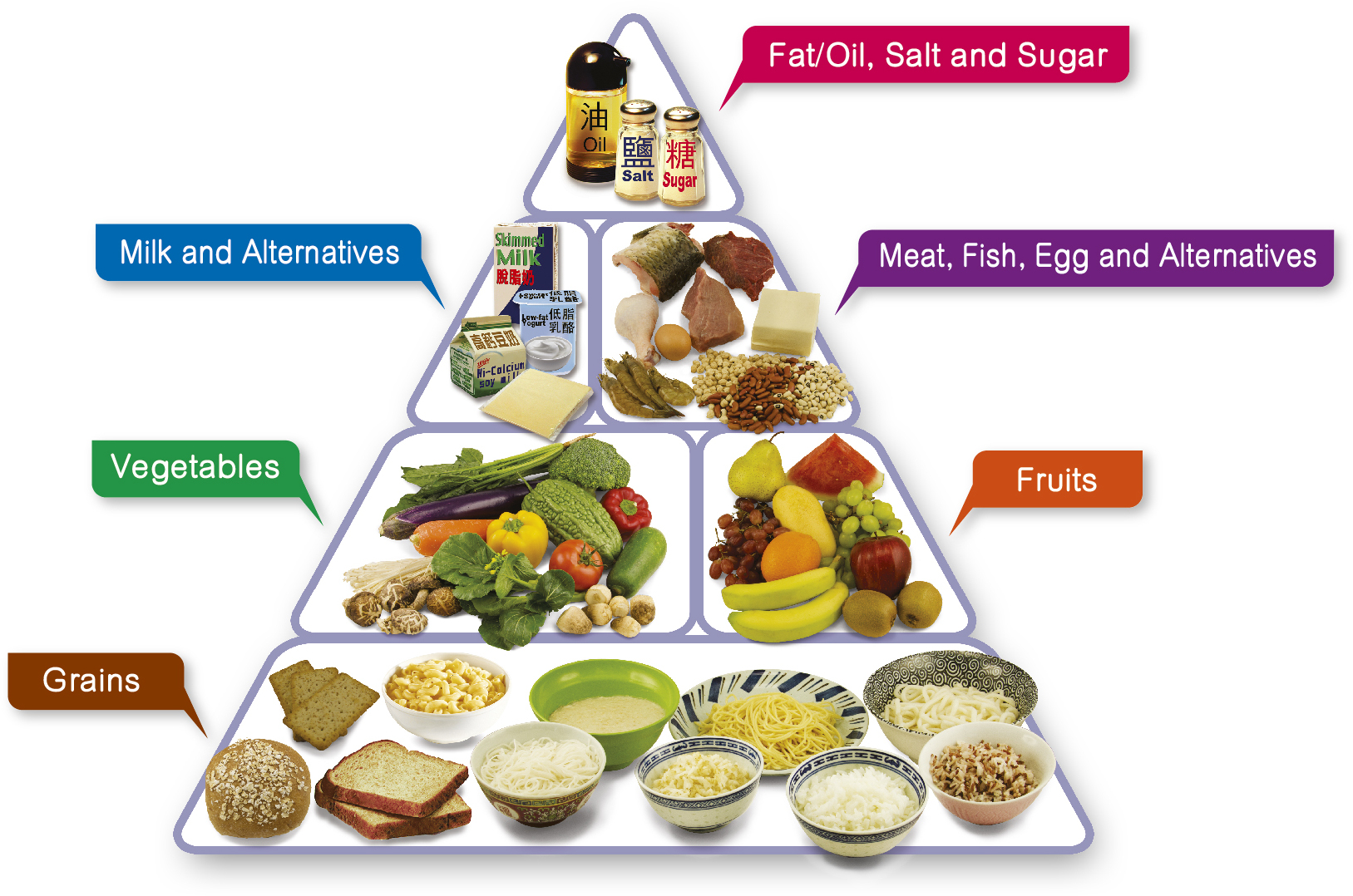The Food Pyramid – A Guide to a Balanced Diet
The Healthy Eating Food Pyramid
Balanced diet is a key to stay healthy. Follow the "Healthy Eating Food Pyramid" guide as you pick your food. Grains should be taken as the most. Eat more fruit and vegetables. Have a moderate amount of meat, fish, egg, milk and their alternatives. Reduce fat/ oil, salt and sugar. Trim fat from meat before cooking. Cook with low-fat methods such as steaming, stewing, simmering, boiling, scalding or cooking with non-stick frying pans. Also reduce the use of frying and deep-frying. These can help us achieve a balanced diet and promote health.How much of different kinds of food should I eat to stay healthy?
Eat the Right Food
Since different foods have different nutritional values, it is not possible to obtain all the nutrients we need from a single food. According to the Healthy Eating Food Pyramid, we have to eat a variety of foods among all food groups as well as within each group in order to get different nutrients and meet our daily needs.Eat the Right Amount
Neither eating too much nor too little is good for our health. Every day, we need a specific amount of nutrients to maintain optimal health. If we do not eat enough, malnutrition or symptoms of nutrient deficiency are likely to develop. In contrast, excessive intake can result in over-nutrition and obesity. Therefore, we have to eat the right amount of food to stay healthy.
Healthy Eating Food Pyramid
- Eat Most - Grains
- Eat More - Vegetables and fruits
- Eat Moderately - Meat, fish, egg and alternatives (including dry beans) and milk and alternatives
- Eat Less - Fat/ oil, salt and sugar
- Drink adequate amount of fluid (including water, tea, clear soup, etc) every day
Healthy Eating Food Pyramid for Children (aged 2 to 5)
- Grains: 1.5 - 3 bowls
- Vegetables: at least 1.5 servings
- Fruits: at least 1 serving
- Meat, fish, egg and alternatives: 1.5 - 3 taels
- Milk and alternatives: 2 servings
- Fat/oil, salt and sugar: eat the least
- Fluid: 4 - 5 glasses
Healthy Eating Food Pyramid for Children (aged 6 to 11)
- Grains: 3 - 4 bowls
- Vegetables: at least 2 servings
- Fruits: at least 2 servings
- Meat, fish, egg and alternatives: 3 - 5 taels
- Milk and alternatives: 2 servings
- Fat/oil, salt and sugar: eat the least
- Fluid: 6 - 8 glasses
Healthy Eating Food Pyramid for Teenagers (aged 12 to 17)
- Grains: 4 - 6 bowls
- Vegetables: at least 3 servings
- Fruits: at least 2 servings
- Meat, fish, egg and alternatives: 4 - 6 taels
- Milk and alternatives: 2 servings
- Fat/oil, salt and sugar: eat the least
- Fluid: 6 - 8 glasses
Healthy Eating Food Pyramid for Adults
- Grains: 3 - 8 bowls
- Vegetables: at least 3 servings
- Fruits: at least 2 servings
- Meat, fish, egg and alternatives: 5 - 8 taels
- Milk and alternatives: 1 - 2 servings
- Fat/oil, salt and sugar: eat the least
- Fluid: 6 - 8 glasses
Healthy Eating Food Pyramid for Elderly
- Grains: 3 - 5 bowls
- Vegetables: at least 3 servings
- Fruits: at least 2 servings
- Meat, fish, egg and alternatives: 5 - 6 taels
- Milk and alternatives: 1 - 2 servings
- Fat/oil, salt and sugar: eat the least
- Fluid: 6 - 8 glasses
Food Exchange List:
1 bowl of grains is equivalent to:
- Cooked rice, 1 bowl
- Cooked rice noodles, 1 bowl
- Bread, 2 slices
1 serving of vegetables is equivalent to:
- Cooked vegetables, 1⁄2 bowl
- Raw vegetables, 1 bowl
1 serving of fruit is equivalent to:
- Medium-sized apple, 1 piece
- Kiwifruit, 2 pieces (small-sized)
- Fruit cuts, 1⁄2 bowl
1 tael of meat is equivalent to:
- Cooked meat, 4-5 slices
- Egg, 1 piece
- Firm tofu, 1⁄4 block
1 serving of milk and alternatives is equivalent to:
- Low-fat milk, 1 cup
- Low-fat cheese, 2 slices
- Low-fat plain yogurt, 1 pot (150g)
Remarks
- 1 tael is approximately equivalent to 40 grams (raw meat).
- 1 bowl is approximately equivalent to 250-300ml
- 1 cup is approximately equivalent to 240ml
- The above recommendations are intended for healthy individuals only. Those with chronic diseases and specific nutritional needs should consult their family doctors and dietitians for individualised dietary recommendations.















